- New Sailors Guide
- SAILSetc DRAWINGS
- 3D PRINT A YACHT !
- MAST, BOOM & RIGGING PARTS
- RIGGING Wire/Spectra/Dyneema
- HULL & DECK FITTINGS
- VANGS - GOOSENECKS
- BOOM SECTIONS
- MASTS Alum & Carbon Fibre
- RIG KITS & RIG PLANS
- FINS AND BULBS
- BOATS - KITS & PLANS
- RG65 - MICRO MAGIC - Parts
- SAILS & SAILMAKING
- WINCHES & DRUMS
- RADIOS SERVOs BATTERIES etc
- POND YACHTS & PARTS
- ACCESSORIES, COVERS & MISC.
- FASTENERS Screws, Bolts, Nuts
- SPARE PARTS
- CLEARANCE ITEMS
- FREE Boat & Rigging Plan Links
- PARTS DRAWINGS
- Print your own CATALOGUE
- Shipping Info
- Privacy Policy
- Conditions of Use
- Newsletter Unsubscribe
- Create Account
- Shopping Cart
| | :: :: ARS-808R ND - High Speed Brushless no drum Write Review This is the higher speed and lower power version of the ARS-808 The New ARS808R Brushless Digital Sail Winch features. -direct fit replacement for rmg equiped boats, same mount holes and rmg drum can be used. -brushless motor -water resistant design IP68 waterproof rating -metal gears and casing -high speed -dual ball bearing races -wide voltage application -4 turns programable with transmitter end points
The Specs. 808R- high speed version Voltage 4.8V - No Load Current 0.85A , Max Load Current 2.50A , Speed 1.95turns/sec, kg/cm 8.5 Voltage 6.0V - No Load Current 0.85A , Max Load Current 2.50A , Speed 2.50turns/sec, kg/cm 11 Voltage 7.4V - No Load Current 0.85A , Max Load Current 2.50A , Speed 3.00turns/sec, kg/cm 13 Voltage 8.4V - No Load Current 0.85A , Max Load Current 2.50A , Speed 3.40turns/sec, kg/cm 16
Note that you will need a rudder servo and receiver able to handle more than 6v to utilise larger battery packs. Typical rudder servos are only rated to 6v and although futaba receivers are rated to 7.6v , some older or cheaper radio gear are not. Whilst winches and other products are rated to ip68 waer proof rating this does not mean they are totally weather proof, clean and dry boats and special care in salt water where dry salt crystals can expand and breach sealing. It is also not recommended to use Lipo batteries or drum barrels over the standard 40mm unit supplied.
Dimensions Height - body, 45mm Height - overall, 54.7mm Length - body dia 52mm Length- mount holes centre to centre 32mm
|
- Vanquish 65
- Mini Maniac
- RG65 Appendages
- Maniac MK II
- IOM Appendages
- Marblehead Class
- Marblehead Appendages
- RT65 Ragnarok
- RT65R Armageddon
- RC65 Adrenaline
- ST65 Sowelu
- Mini40 / F48 Class
- Nightmare X
- Nightmare MK VIII
- MultiOne Class
- FireDragon 1000
DIY Sail Winch
- Rig Building
| Here are four most popular commercial sail winches used in boat classes between 90 cm and 1.50 m length: - from Australia - Powerful, fast, the most famous - from Graupner, Germany - from Robbe, Germany - and 180 degree servos, or airplanes There are some less powerful, slower winches often used in smaller sailboats: - - The 1, 3 turns and 6 turn sail winches There are new, interesting sail winches from Hong Kong: - , or cheap like standard servo but powerful and waterproof. Or, you can build your own drum winch as follows. You can find a and many other R/C parts here. The is very cheap and stocked by many merchants around the globe.
We have designed a kit including the two gears with an integrated drum and a base plate which fits the MG995 servo to save you a lot of work, the kit can be ordered from |
| Open Servo (4 screws underneath), unsnap the top cover and locate the steel pin that prevents full rotation of the servo. With a good plier you can pull the pin out. Replace the cover over the gears. |
| Identify the three wires that go to the servo's potentiometer, remove the screw that holds the potentiometer in place, and remove it. |
| Unsolder the potentiometer after marking the middle wire, extend the wires and isolate with heat shrink tubing. (You can also unsolder the wires and replace with longer wires if you don't fear to unsolder from the PCB (Printed Circuit Board)). Drill a hole in the servo body, slide the wires through, and reassemble the servo. |
| A Hitec servo is more delicate because the PCB is directly soldered to the motor terminals and potentiometer. You need to desolder the potentiometer and then resolder the new wires ... Delicate but not impossible with a good clean iron and desoldering braid. |
| Get two gears roughly the same size, the one on the picture comes from a inkjet printer, but you can use any gears that fit. Cut a rectangular hole to accomodate the servo into the epoxy plate, then drill a hole with about 12mm diameter for the potentiometer shaft in the place that works for your gears. Drill a hole of about 9.5 mm (depends on the potentiometer you use) in a second smaller epoxy plate as shown in the picture. If your gear's bore does not fit the potentiometer shaft you need to make an adapter. It does not need to be a precision thingy, there is not much force on the gear. Attach the potentiometer to the small plate through the 12mm hole of the large plate and glue the gear in place. |
| The other gear's bore is drilled open to a size that allows it to slide on the lower bushing of the servo disc. The servo disc is secured to the gear with two or three bolts through both parts. Attach the subassembly with the original screws. |
| With the large epoxy plate secured in place adjust the gears. Check that the gears are in contact, if not adjust the hole in the large plate with a round file. Adjust the gears for a tiny play by moving the potentiometer on with the small plate, then glue the small plate in place on the large plate. Now solder the wires from the servo to the external potentiometer. The middle potentiometer wire goes to the bottom terminal, the other wires to the two leftover terminals. Without the servo's gear installed plug the servo into the receiver and switch on power. Turn the potentiometer by hand if the servo rotates inverted, simply change the two outer wires. Recheck, attach the servo disc and insulate the hole where the wire run through and the potentiometer terminals with silicone. You only need to find a drum to attach and your winch is ready. Basically you get 3 turns, but you can increase the turns by soldering additional resistors of around 2.2kOhms (1/4 Watt) inline with the two outer potentiometer wires. |
*HITEC WILL BE CLOSED 9/2/24 TO OBSERVE LABOR DAY*
Customer Service: M-F/ 8a-4:30p PST

- Hitec Japan
- Hitec Korea
- Hitec Germany
- HS-785HB Karbonite, 3.5 Turn Winch Servo
Part No: 33785S


Buy it Now:
Product description.
The HS-785HB sail winch servo with its large drum wheel has 3 1/2 revolutions of travel for hauling in even the largest of sails. With its dual ball bearing supported output shaft the HS-785HB will provide years of reliable service.
- Large Drum Wheel with 3.5 Revolutions of Travel
- Strong Karbonite Gear Train
- Dual Ball Bearing-Supported Output Shaft
- Water and Dust-Resistant Case
Accessories
- Karbonite Gear Set | Link |
- Plastic Case Set | Link |
- Applicable Horns
HS-785HB Servo Specifications
| Operating Voltage Range (Volts DC) | 4.8V ~ 6.0V |
| Speed (Second @ 60°) | 1.68 ~ 1.38 |
| Maximum Torque Range oz. / in. | 153 ~ 183 |
| Maximum Torque Range kg. / cm. | 11.0 ~ 13.2 |
| Current Draw at Idle | 8 mA |
| No Load Operating Current Draw | 250 mA |
| Stall Current Draw | 1,800 mA |
| Dead Band Width | 5 µs |
| Dimensions (Inches) | 2.32 x 1.14 x 1.96 |
| Dimensions (Metric) | 59.0 x 29.0 x 50.0 |
| Weight (Ounces) | 3.88 |
| Weight (Gram) | 110.0 |
| Circuit Type | HT7003 Analog MosFet |
| Motor Type | 3 Pole Metal Brush Ferrite |
| Gear Material | Karbonite |
| Bearing Type | Dual Ball Bearing |
| Output Shaft (type / Ømm) | Standard 24 |
| Case Material | Plastic |
| Dust / Water Resistance | Splash Proof |
| Connector Gauge (AWG) / Strand Count | 22 / 60 |
| Parkflyer | N / A |
| Sport Plane | N / A |
| Sailplane | N / A |
| 3D Performance | N / A |
| Scale | N / A |
| Electric Helicopter | N / A |
| Gas Helicopter | N / A |
| On Road | N / A |
| Monster Truck | N / A |
| Buggies | N / A |
| Truggies | N / A |
| Short Course / Truck | N / A |
| Crawlers | N / A |
| Sail Boat | =>1M+ & Scale |
| Power Boat | N / A |
- HS-765HB Karbonite, Sail Control Servo
Home | Servos | Chargers | Transmitters | Receivers | Aircraft | Where to Buy | Support | TecTalk | About | Contact | Site Map | CMS Login

HITEC RCD USA, Inc. • 9320 Hazard Way Suite D, San Diego, CA 92123 • Ph: 858.748.6948 • Fax: 858.748.1767
©2024 Hitec RCD USA, Inc. • The materials used and displayed on the Service and the Sites, including but not limited to text, software, photographs, graphics, illustrations and artwork, video, music and sound, and names, logos, trademarks and service marks, are the property of are the property of Hitec Group USA, Inc. or licensors and are protected or its affiliates or licensors and are protected by copyright, trademark, and other laws.

- New Sailboats
- Sailboats 21-30ft
- Sailboats 31-35ft
- Sailboats 36-40ft
- Sailboats Over 40ft
- Sailboats Under 21feet
- used_sailboats
- Apps and Computer Programs
- Communications
- Fishfinders
- Handheld Electronics
- Plotters MFDS Rradar
- Wind, Speed & Depth Instruments
- Anchoring Mooring
- Running Rigging
- Sails Canvas
- Standing Rigging
- Diesel Engines
- Off Grid Energy
- Cleaning Waxing
- DIY Projects
- Repair, Tools & Materials
- Spare Parts
- Tools & Gadgets
- Cabin Comfort
- Ventilation
- Footwear Apparel
- Foul Weather Gear
- Mailport & PS Advisor
- Inside Practical Sailor Blog
- Activate My Web Access
- Reset Password
- Customer Service

- Free Newsletter

Mason 33 Used Boat Review

Beneteau 311, Catalina 310 and Hunter 326 Used Boat Comparison

Maine Cat 41 Used Boat Review

Cheoy Lee Clipper 36 & 42 Used Boat Review

Tips From A First “Sail” on the ICW

Tillerpilot Tips and Safety Cautions

Best Crimpers and Strippers for Fixing Marine Electrical Connectors

Thinking Through a Solar Power Installation

Stopping Mainsheet Twist

Working with High-Tech Ropes

Getting a Clue for the Blown-Out Clew

Monel Seizing Wire is Worth the Extra Cost

Fuel Lift Pump: Easy DIY Diesel Fuel System Diagnostic and Repair

Ensuring Safe Shorepower

Sinking? Check Your Stuffing Box

The Rain Catcher’s Guide

Boat Maintenance for the Technically Illiterate: Part 1

Whats the Best Way to Restore Clear Plastic Windows?

Mastering Precision Drilling: How to Use Drill Guides

Giving Bugs the Big Goodbye

Galley Gadgets for the Cruising Sailor

Those Extras you Don’t Need But Love to Have

UV Clothing: Is It Worth the Hype?

Preparing Yourself for Solo Sailing

How to Select Crew for a Passage or Delivery

Preparing A Boat to Sail Solo

On Watch: This 60-Year-Old Hinckley Pilot 35 is Also a Working…

On Watch: America’s Cup

On Watch: All Eyes on Europe Sail Racing

Dear Readers

Chafe Protection for Dock Lines
- Sails, Rigging & Deck Gear
Six-Brand Winch Test: Anderson On Top
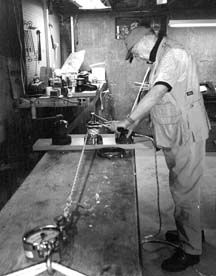
Anyone who has been on the bitter end of the sheet when a big genoa starts to fill—whipping and shaking with terrifying violence—knows how important it is to have a winch to convert that flailing energy to forward propulsion.
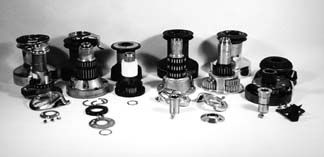
Winches are to sailboats what the inclined plane was to the Egyptians.
They make the difficult easy, place the impossible within reach.
The equivalent of a dozen or more men needed to heave on a square rigger’s halyard or brace is represented on a modern sailboat by a small, precision-made, cylindrical machine packed with levers and gears.
The refinement of gearing and the development of smooth-operating self-tailers has promoted modern winches from two-man to one-man workhorses with amazing power.
Their only negative is their proclivity to induce fidgety idlers to rotate them mindlessly, just to hear the pawls ratchet. These idlers usually can be broken of this annoying habit by shouting, “Winchclicker! Winchclicker!! Winchclicker!!!” If that fails, they generally are put ashore (if in harbor) or put to death (if on a long sea voyage).
Let’s take a close look at two common sizes of winches. They’re all expensive, because they are well-made precision equipment. They’re also among the most frequently retrofitted items; it’s worth repeating here that an oft-heard saying aboard a lot of sailboats is that the winches they came with are not big enough.
In the two categories selected, these winches are from six manufacturers—Andersen (Denmark), Antal (Italy), Barton (England), Harken (United States), Lewmar (England) and Setamar (Germany).
Small Winches The first category is very small winches. Those represented in this evaluation are among the smallest made by five of the manufacturers. One maker, Antal, makes excellent small winches in several sizes, but could not supply one for testing.
Small, single-speed winches, either with a handle or simply snubbing winches, are invaluable on small boats, for halyards, jib sheets, spinnaker sheets, reefing gear, vangs, etc., and handy, too, for many tasks aboard larger boats. Small winches do not come with the self-tailing mechanism; most manufacturers (Andersen is the exception) start the self-tailers with #16s, which also happens to be the minimum size for two-speed gearing.
Small winches are said to have a gear ratio of 1:1. That means they are direct drive. The only power advantage is that provided by a winch handle. It’s simple leverage, with two sets of pawls (one pair to restrain the drum; the other pair to permit the handle to ratchet freely). One turn of the crank is one turn on the drum. On a small boat, the single-digit power ratio provided by the handle often is ample for sheets. Non-geared winches take in line rapidly. Such winches often are used for halyards on somewhat larger boats. (The power ratio is the length of the handle divided by the radius of the drum.)
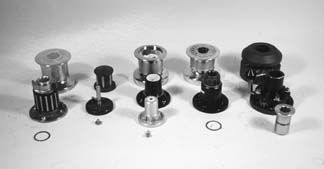
Snubbing winches, which do not accept a handle, turn in one direction only. They need only a single set of ratchet pawls. If enough wraps are applied, snubbing winches give the user time to get a new grip or to simply hold the line lightly while friction between the drum and the line takes the load.
They provide little mechanical advantage, but snubbing winches facilitate a good utilization of intermittent muscle power, They also have good line retrieval speed, which always is a consideration when dealing with winches.
Simple and trouble-free, they are of great value when the line load is no more than one’s weight or pulling strength. A halyard can be sweated up very taut by the “heave and hold” method of pulling hard on the line perpendicular to the mast with one hand while grabbing slack on the winch with the other hand.
With either small, direct-drive winches with handles or simple snubbers, the line retrieval rate is an undiluted derivative of the drum diameter, i.e. one revolution of the winch hauls in a length of line equal to the drum’s diameter multiplied by that popular symbolic 16th letter in the Greek alphabet. As a practical matter, line in equals line out.
Because they are simple devices, these small winches were not tested.
The Roaring 40s The second category is the very popular “Number Forties.” Winches are given numbers that correspond to their lowest and most powerful gear ratio. The power ratio of a geared winch is the length of the handle divided by the radius of the drum, multiplied by the gear ratio.
The big winches in this test are Andersens, Antals, Bartons, Harkens, Lewmars and Setamars. We tried to include the Australian-made Murray bottom-action winches, but could not find a U.S. distributor.
The versatile #40s—or their close equivalents—serve as genoa sheet winches on 30- to 35-foot boats, for spinnaker sheets and mainsheets on boats up to 48′, and for halyards, topping lifts, vangs, etc., on much larger sailboats.
The #40s in this collection are all two-speed. Three-speed winches usually are found on racing boats; they come in bigger sizes and get complicated and expensive.
All but one of these winches are self-tailing. In the beginning, several decades ago, self-tailing winches were troublesome…as is usual with most new things. Now perfected, the self-tailing mechanisms represent the only way to go on either racing or cruising boats.
Because winches are such beautifully made gear and rarely get worn out, marine consignment shops across the country are clogged with standard winches—mostly Barients—that once were highly coveted (as well as highly priced). We know of at least one instance in which dozens of perfectly usable standard winches were sold as scrap metal.
There even are a few early-model self-tailers (from various manufacturers) showing up now in the consignment shops; they’re okay for moderate duty but, generally speaking, are not good buys because the self-tailing mechanisms often are not as refined as those on current models. In plain English, that means they slip under heavier loads. Many also have abrasive drum surfaces that devour line.
The Test The Practical Sailor test, designed to establish efficiency ratings for winches, involves mounting each winch on the workbench.
To measure the force exerted, a 15″ torque wrench was used instead of a standard 10″ handle. (The extra length of the torque wrench required adjustments in the calculations.)
Sta-Set X, a modern, rather slippery line, was used, with some of the early tests repeated using Regatta braid, a fuzzy-finish line. The theory that because of varying friction a slippery line might produce different numbers than a fuzzy line proved specious.

At the other end of the bench, a tripled length of 1/2″ shock cord held by two eye straps provided the resistance. Shackled to the shock cord was a carefully calibrated Dillon dynamometer with a handy red max needle. The Sta-Set was attached to the other shackle on the dynamometer and thence to the winch. Four wraps were used. A minimum of three generally is recommended for all but extreme loads. The exception was the Setamar, which requires just one partial wrap of at least 220°.
Pulls of 10 and 20 pounds were for the trimmer easy work. Additional pulls of 30 pounds produced some sweat. A pull of 40 pounds probably would be regarded by an average person as a maximum effort; 50 pounds would be something only a bench-pressing girlfriend would do without making some kind of noise.
The numerous pulls produced figures whose averages indicate how close each winch came to meeting its power ratio.
An additional step in the testing was to determine how easy it is to free the line from the self-tailer and ease the line, as one would do in easing a sheet or halyard when coming off a beat onto a reach or run. In the case of the Setamar, this becomes complicated and is controlled by the handle.
The Results First of all, the fact that the smooth-skinned Sta-Set performed the same as fuzzy Regatta braid indicates that the gripping action of the self-tailing mechanisms on all of these winches probably is no longer at issue. There were difficulties when self-tailers were first introduced; that was before it was recognized that the diameter of the drum and the base diameter of the self-tailer were very critical dimensions.
Click here to view the Winches Value Guide .
There appeared to be no slippage. However, the sharpness of the teeth on the self-tailers’ disks may well affect wear on the line.
Dealing first with the small winches, there are lots of places on small boats where the ultra-simple Barton snubbing winch (about $50) would be useful. The almost equally simple Lewmar #6 ($92 in anodized aluminum) has an efficient mechanism; it also comes (for more money) in chromed or polished bronze. The #6 Harken ($108 for aluminum) turns on sleeved bearings and is the smoothest operating.
For small-boat sheets or bigger-boat halyards and vangs, the small single-speed Setamar ($364) makes eminently good sense. The ability to ease a sheet or halyard by turning the handle in the opposite direction, before freeing the line entirely, constitutes, in our opinion, a valuable safety factor. As was pointed out in an earlier, more detailed review (in the February 15, 1997 issue), the drum-less Setamar winches are very ingenious and may represent the design approach of the future. However, they currently are too expensive.
The Andersen #6 ($102), all-stainless, beautifully made, with Andersen’s ribbed drum and needle bearings, commands categorization as top-of-the-heap and Best Buy.
Summarizing now about the large winches, it’s tough to choose between Andersen and Lewmar. But first, let’s review the others.
The little Barton G23 is not comparable with the big 40s. It was included not only because it’s Barton’s biggest winch, but also because it may point to the future. An “Ugly Ducking”, if there ever was one (see photo), the Barton is made largely of reinforced plastic (including plastic needle bearing), but with a stainless steel axle, pawls and planetary drive gears made of sintered stainless, and a stainless sleeve on the plastic drum. The winch is a powerhouse and, along with being very light and corrosion free, requires almost no service. An occasional flushing with an optional light hit of WD40 is all it needs. It’s a $400 workhorse.
Although handsome winches and very finely made, both the Harken and Antal suffer from what appear to be unnecessarily complicated innards that produce some fall-off in efficiency. They suffer especially in their geared high speed modes and make the initial retrieval of line quite slow compared with the Setamar, Andersen and even the Lewmar.
In addition, the Practical Sailor tests revealed that the Harken drum surface caused abrasion on the Sta-Set line that was easily detected visually after only three or four “pulls.” The Harken and Antal have the most abrasive drums.
The Setamar? It’s so different, it’s difficult to compare with the more conventional #40s. It has a number of strong points. The principal ones are that it retrieves line fast (as fast as the Andersen) and easing of a loaded line can be controlled very safely with the handle (after shifting the top ring). Other benefits are that no wraps are needed; it is small and very lightweight, and line wear is the lowest of all.
The Setamar negatives: It is not a thing of beauty; is complicated to strip and clean (which it requires often); takes some “getting used to,” and it is far too costly.
Both the best and the Best Buy is the Andersen, but there’s almost no gap between it and the Lewmar.
The Lewmar, a first-rate value, is part of a line that was completely redesigned a few years ago to simplify the gearing, reduce the number of parts and make the winch both stronger and easier to service.
The Lewmar ranks first in efficiency, a hair ahead of the Andersen, and is easy to disassemble. If it had a drum as good as the Andersen, it would be a toss-up.
The Andersen has a direct drive high gear that retrieves line fast, a good low gear mechanism that may come second to the bearing-packed Harken, but its real forte is the polished stainless steel drum. The drum, a masterpiece of metal-working, is ribbed, which produces very little abrasion because it moves the coiled line up the drum much better than an abrasive drum. The drum should last virtually forever.
A peculiarity of the Andersen is that when the line is heavily loaded, easing the line can be a bit jerky as the line skips from rib to rib. Although initially disconcerting, it is not even a minor problem.
There’s nothing second-rate about any of these winches. They all work very, very well and last a long time if properly cared for. The choice may involve gear ratios, serviceability or even cosmetics (we still believe a good part of a sailboat’s appeal is aesthetic).
If it’s something different you want, try Setamar. If you don’t need a large winch, don’t overlook the “new-tech” Bartons. But for efficiency, serviceability, construction and appearance, our top choice is the Andersen.
Contacts- Andersen, Scandvik, Inc., 423 4th Pl. SW, Vero Beach, FL 32961-0068; 561/567-2877. Antal, Euro Marine Trading, Inc., 62 Halsey, Newport, RI 02840; 800/222-7712. Barton, Imtra Corp., 30 Samuel Barnet Blvd., New Bedford, MA 02745; 5008/005-7000, www.imtra.com. Harken, 1252 E. Wisconsin, Pewaukee, WI 53072; 262/691-3320; www.harken.com. Lewmar, New Whitfield St., Guilford, CT 06437; 203/458-6200; www.lewmar.com. Setamar, Setamar USA, Box 840, 17 Burnside St., Bristol, RI 02809; 401/253-2244.
RELATED ARTICLES MORE FROM AUTHOR
Leave a reply cancel reply.
Log in to leave a comment
Latest Videos

The Perfect Family Sailboat! Hunter 27-2 – Boat Review

Pettit EZ-Poxy – How to Paint a Boat

The Boat From True Spirit – Sparkman & Stephens

Top 5 Boat Hacks – Boat Maintenance Tips and Tricks
Latest sailboat review.

- Privacy Policy
- Do Not Sell My Personal Information
- Online Account Activation
- Privacy Manager

Return to RC Sailboats
RC Sailboat Controls – Radio Layout, Radio Setup
RC Sailboat Controls are rather different then your typical Radio Control.
We will first look at what channels on the radio control transmitter, control which part of the RC Sailboat and then we will look at the specific setup concerning the radio gear on an RC Sailboat.
Transmitter Channels and Controls – RC Sailboat Controls
The most common type of transmitter for RC Sailboats are the stick type transmitters . The stick type transmitter allows the ease of use over the sail control. On a stick type transmitter referring to the image below, the left

RC Sailboat Controls
side channel, typically throttle on an airplane controls the Sails. Moving the left side stick up or down would draw the sail in or let the sail out. Motion on the stick is vertically.
The stick on the right hand side controls the rudder on the RC Sailboat. The rudder channel operates as like any other rudder channel. Motion on the stick is horizontally.
These two channels are the required minimum for RC Sailboat Controls. You can see all the extra switches and controls on the radio to the right. These may be used for controlling those fancy features on your RC Sailboat. In some cases these extra features include alternate lighting, winches, or anything else to make the sailboat appear and operate more scale like.
Radio System Controls – RC Sailboat Controls

RC Radio Receiver
Now that we have talked about the transmitter we will look at the rest of the components that are required in order to run an RC Sailboat. The component that is responsible for talking to the transmitter is the receiver. The receiver is what talks to the transmitter and then converts the radio signal to an electrical signal that can be used to control the rudder and sails of a sailboat. The reciver can be purchased with the transmitter if you choose to take that route. Purchasing a transmitter/receiver combination is more common when building your own boats.
Receiver Battery – RC Sailboat Controls
To power the radio equipment a standard receiver battery is required. This is a battery that operates on 4.8-6.0v. Although a 4 cell disposable AA case can be used, it is highly recommended for an RC sailboat to use a rechargeable battery . The main reason is to ensure the battery pack can supply a sufficient amount of current to the servos. For larger RC sailboats a rechargeable battery is a requirement. The average user would use a 4.8-6.0v NiMh pack however LiFE, Li-ion, LiPo packs are available but be certain to include a Voltage Regulator in your system to limit the voltage.
Sail Servo – RC Sailboat Controls
The most important servo for an RC Sailboat is of course the Sail Servo. The sail servo comes in two different styles that are most common. Each style has its own specific set of advantages and disadvantages. The first style of sail servo that we will talk about is the sail winch servo.
The sail winch servo as pictured on the right hand side uses a drum like wheel to house the sail line. When the drum rotates the line is either let out or brought in. The Sail winch servo typically allows for 3 rotations of the drum with

Sail Servo Winch – Sail Servo – RC Sailboat Controls
torque specs around the 150 oz-in / 11 kg-cm. The biggest difference is that these torque specs are at a relatively short distance from the center point of the drum. This small distance increases the amount of torque relative to the next sail servo type that we will be looking at.
Sail Winch Servo Advantages:
- Amount of force generated to pull in the sails
- Amount of total line length (travel) that can be brought in – approximately 3 revolutions of the drum
- Relatively Small Space Requirement, even with larger servo sizes
Sail Winch Servo Disadvantages:
- Slow Reaction time relative to transmitter input as winch must rotate up to 3 times

Sail Arm Servo – RC Sailboat Controls
The other Sail Servo style is the arm type . The arm type sail servo uses quite a long arm in order to get an acceptable amount of line draw. As you may expect this operates nearly the same as a standard servo where the only difference is the servo arm itself. For a typical one meter Sailboat, you would require a servo of this style that has at least 150 oz-in / 11 kg-cm of torque as a minimum. This style servo requires more torque then a winch servo as the amount of force produced at the end of the arm is reduces due to the length of the arm.
Sail Arm Servo Advantages:
- Very quick response time vs the Sail winch Servo
- More servo options as any standard servo can be used with a long sail arm. Options for very high torque servos are available
- Line has less chance of getting tangles or wrapped upon itself as compared to the winch style servo
Sail Arm Servo Disadvantages:
- Require a lot of space due to the radius of the outer point of the sail servo arm
- Lower amount of Line Draw force due to length of Arm requiring higher torque at the servo for equal performance that of a winch style servo
- Generally has a smaller total line length(travel) that can be brought in resulting in lower amount of sail movement (travel)
Steering Servo – RC Sailboat Controls
Radio Control Info Articles
- 3D Printing (2)
- General Electric (44)
- General Radio Control (13)
- Patreon Posts (104)
- RC Airplanes (6)
- RC Boat (3)
- RC Cars/Trucks (19)
Recent Articles
- Next Battery to be Tested! August 17, 2024
- RC Battery Sheet V24.08 Released – Traxxas Battery Added August 4, 2024
- New to RC? Avoid These 7 Rookie Mistakes and Save Big Time! July 20, 2024

- Forums New posts Unanswered threads Register Top Posts Email
- What's new New posts New Posts (legacy) Latest activity New media
- Media New media New comments
- Boat Info Downloads Weekly Quiz Topic FAQ 10000boatnames.com
- Classifieds Sell Your Boat Used Gear for Sale
- Parts General Marine Parts Hunter Beneteau Catalina MacGregor Oday
- Help Terms of Use Monday Mail Subscribe Monday Mail Unsubscribe
Mounting winches
- Thread starter Ted
- Start date Apr 25, 2014
- Forums for All Owners
- Ask All Sailors
I was having a conversation with one of my marina mates the other day regarding mounting winches. I know that some manufacturers want their winches orientated in a specific direction in relation to the load from the incoming line. Something about how that load relates to one of the internal gears or shafts. I just couldn't remember. We're not talking about the orientation of the stripper arm on a self tailing winch. Specifically the winches in question were Barient #24 self tailing winches but this information may be generic to most manufacturer's mounting instructions. Does anyone remember coming across these directions when mounting their winches?
heart of gold
When I mounted my Harken 46's the instructions were very specific in the mounting orientation. They wanted them mounted so that the drive gear is in line with the sheet entry point. Here is a link the manual for the 46's. http://www.velasailingsupply.com/v/vspfiles/files/PDF/Winch_46.2ST_2007.pdf
Ted said: I was having a conversation with one of my marina mates the other day regarding mounting winches. I know that some manufacturers want their winches orientated in a specific direction in relation to the load from the incoming line. Something about how that load relates to one of the internal gears or shafts. I just couldn't remember. We're not talking about the orientation of the stripper arm on a self tailing winch. Specifically the winches in question were Barient #24 self tailing winches but this information may be generic to most manufacturer's mounting instructions. Does anyone remember coming across these directions when mounting their winches? Click to expand
I just mounted Andersen #12 STs. For their #12s and #28s, their manual has a diagram of a boat and shows circles for each the standard mounting locations with a shaded area for where they recommend the ST arm to be pointed. This may be because the ST arms are in fixed positions? http://www.defender.com/pdf/ander12stmanual.pdf
Stu Jackson
The inherent issue is to get a good fairlead.
You can get wood blocks with different pitch of inclination for mounting winches at any reputable marine chandlery. To avoid overwraps and better distribute the loads it is advisable the winch sits at 90 degrees from the plane of the incoming line. Always use three wraps to distribute the load along the drum; saves the bearings.
Thanks. That's the answer I was looking for. The loaded line should be tangent to the drive gear as in the illustration from Harken and Lewmar. I would assume this installation detail holds true for other manufacturers. Greatly appreciated.
I prefer missionary myself. Oops - "I" not "e"!! ;-) Sorry, after a few rums, couldn't resist.
This link includes diagrams and instructions for most Barient winches: http://www.cncphotoalbum.com/indexes/winches.htm A gear orienting mistake that I made when installing my new winches seven years ago, and also the same one that a few others on this site through the years have admitted to also doing: - I paid careful note to the orientation for my port winch with the drive gear side oriented where the sheet enters the drum which facing inboard. Then in a moment of mis-applied intuitive logic, I simply mirrored for the starboard winch and mounted that with the drive gear again to inboard. Wrong -- since winches are loaded clockwise (when looking down), the starboard winch drive gear should have been oriented outboard. I realized my mistake after drilling the mounting holes for the starboard winch. The mounting holes in the baseplate are not evenly spaced around the radius, so it was not a simple matter of just rotating the orientation. New holes needed drilling. I called Harken to find out how critical the issue. He said all would work fine ... for a while. But over time the winch would experience premature wear. I opted to do it right.
- This site uses cookies to help personalise content, tailor your experience and to keep you logged in if you register. By continuing to use this site, you are consenting to our use of cookies. Accept Learn more…

NAMBA 8 RC Model BOAT RACING
Namba 8 upcoming events.

ERCU Race #10 – Detroit Memorial Regatta
Woodland Creek Park 6647 Pacific Ave SE, Olympia, WA 98503
View Detail

Classic Thunder Race #9 – Seafair Regatta
Waughop Lake Waughop Lake Loop, Lakewood, WA 98498, USA

Classic Thunder Race #10 – Bill Muncey Cup

ERCU Race #11 – Gold Cup

2024 NAMBA Nationals
Sunset Park – Las Vegas, NV 2601 Sunset Rd, Las Vegas, NV 89120

ERCU Race #12 – Atomic Cup
Vance Creek Park Wenzel Slough Rd, Elma, WA 98541

District 8 Points Race #9
Twin Lakes 16324 Twin Lakes Ave, Marysville, WA 98271
JOIN DISTRICT 8
Copyright 2020, NAMBA – District 8. All Rights Reserved. Created by Caines Design .
- Classifieds
- Remember Me Forgot Password?
- Boats Sailboats Discussion Best sail winch servos with the most power
| Page 1 of 2 | 1 |
| . | |
| . | |
| . | |
| . | |
| John | |

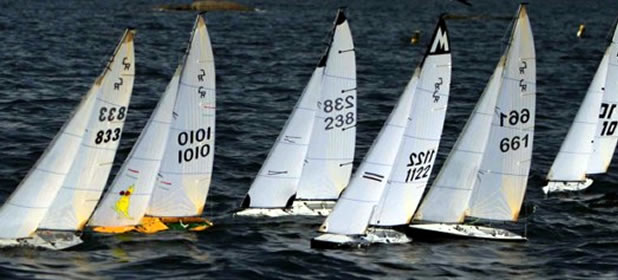




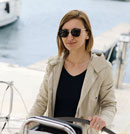



















IMAGES
COMMENTS
1/25 (36") Scale America's Cup high performance model sailboat. View Page. EC12 Meter. 5ft Replica of the 1962 Americas Cup 12 Meter ... View Page. J Class Boat-Shamrock V. 1/16 (8'-10')Scale Replica of the 1930's America's Cup Class Yacht. View Page. RMG Sail Winches. High Performance sail control winches. View Page. Home; ... surface mount ...
Red Ant's new sail winches and high voltage rudder servos are the latest addition to the Red Ant range of components and complete kits. ... It's also a direct mount replacement for the RMG, which can be difficult to source. Find out more. Stinger winch specifications Download. Red Ant's Stinger winch in action
1/25 (36") Scale America's Cup high performance model sailboat. View Page. EC12 Meter. 5ft Replica of the 1962 Americas Cup 12 Meter. View Page. Star 45. 45" Scale Model of the Olympic Star Boat. View Page. J Class Boat-Shamrock V. ... RMG Winch Mount. RMG-Bracket1. Price: 20.00. RMG Winch Mounting Bracket
New Sail winch. This is the first (of the 3rd prototype) winch made. Very happy with the result. Comparable with the RMG exept in cost. A GRP mounting plate (not shown) will be fixed under the drum with 2 holes for fixing. Dimensions - Length 54mm. - Width 36mm. - Height 76mm. Comments welcomed.
This is the higher speed and lower power version of the ARS-808. The New ARS808R Brushless Digital Sail Winch features. -direct fit replacement for rmg equiped boats, same mount holes and rmg drum can be used. -brushless motor. -water resistant design IP68 waterproof rating. -metal gears and casing. -high speed. -dual ball bearing races.
Discussion Sail winch install suggestions Sailboats. Forums; Magazine; Blogs; Classifieds; Places; More; Search; Sign Up ... Mounting to one side allows a longer single arm - more travel, less torque. ... GWS S125 1T sail winch servo: bovick: RC Boats (FS/W) 2: Mar 28, 2013 01:18 AM: Sold:
Page 2-Discussion Sailboat Winch Set-Ups Sailboats. benndave: One trick I saw with plastic arms is rather than using blocks on the ends of the arms or large holes as you have, is to go to the local beading or craft store (beading is a big hobby now) and find some large diameter glass beads that have center holes for stringing.
1/25 (36") Scale America's Cup high performance model sailboat. View Page. EC12 Meter. 5ft Replica of the 1962 Americas Cup 12 Meter. View Page. Star 45. 45" Scale Model of the Olympic Star Boat. View Page. J Class Boat-Shamrock V ... RMG Winch Mounting Bracket Aluminum Mounting bracket is CNC cut to except the RMG mounting screws. The base of ...
RMG Winch (290 J1) | Sailboat RC. RMG winch for IOM sailboats - great longevity and big performance boost. Let your RC yacht sail for years without any hassle around your sails electromotor!
The most important r/c part of a radio controlled sail boat is the sail winch. Here are four most popular commercial sail winches used in boat classes between 90 cm and 1.50 m length: - RMG sail winch from Australia - Powerful, fast, the most famous. - Regatta sail winch from Graupner, Germany. - Sail Winch SW-2 from Robbe, Germany.
This is the easiest way to set your winch servo and sail in average winds. You need a 20 Kilograms servo or greater.
DF65 DF95 Winch + Drum (NEW, upgraded version) › Sailboat RC. DF65 and DF95 winch for sails, new upgraded version. Drums included in package!
The HS-785HB sail winch servo with its large drum wheel has 3 1/2 revolutions of travel for hauling in even the largest of sails. With its dual ball bearing supported output shaft the HS-785HB will provide years of reliable service. Features. Large Drum Wheel with 3.5 Revolutions of Travel; Strong Karbonite Gear Train
Top is sail winch. Line runs from copper tube tostern, around a 180 turning block to top of deck and then forward to jib. Near the stern, the mainsheet is attached to the long jib sheet so both move togehter. Fine adjustment is made at the mainsail boom and the jib boom. On the bottom is the rudder servo but without the pushrod connecting to ...
The Test. The Practical Sailor test, designed to establish efficiency ratings for winches, involves mounting each winch on the workbench. To measure the force exerted, a 15″ torque wrench was used instead of a standard 10″ handle. (The extra length of the torque wrench required adjustments in the calculations.)
For larger RC sailboats a rechargeable battery is a requirement. The average user would use a 4.8-6.0v NiMh pack however LiFE, Li-ion, LiPo packs are available but be certain to include a Voltage Regulator in your system to limit the voltage. Sail Servo - RC Sailboat Controls. The most important servo for an RC Sailboat is of course the Sail ...
Jan 26, 2005. 1,259. C&C 110 Bay Shore, Long Island, NY. Apr 25, 2014. #1. I was having a conversation with one of my marina mates the other day regarding mounting winches. I know that some manufacturers want their winches orientated in a specific direction in relation to the load from the incoming line. Something about how that load relates to ...
NAMBA 8 RC Model BOAT RACING. Representing the North American Model Boating Association in Washington, Oregon, Idaho, and Montana. JOIN NAMBA. Apply to become a NAMBA member or renew your membership here. CLUBS. Check out our many local and regional clubs. REGISTER TO RACE.
Only wondering what others are using for sail servos, for arm winch setups in boats with over 1000 sq inches of sail area. I love RMG winches, and have rigged several boats with them. ... Proportion control, driven from popular servos. All that is done is an extra reduction added and a fancy mount created. A decent, mid price, durable solution ...
Dutton-Lainson StrongArm TW4000 1500 lb 12 volt electric boat trailer winch, rated for loading boats up to 4000 lbs. It works fine, I just prefer the manual winch style. List price new is $399....
Excellent Fishing Boat- stored inside when not in lake, never used in salt water Pro-kicker motor Family sickness forces sale The 185 Explorer is big on value, built with the no nonsense fisherman in mind, its extra wide, deep, and made to tame big water. Length 18' 5" Beam 96" Side Height 34" Chine Width 72" Dead Rise 16° Bottom Thickness 0.190"
1/25 (36") Scale America's Cup high performance model sailboat. View Page. EC12 Meter. 5ft Replica of the 1962 Americas Cup 12 Meter. View Page. Star 45. 45" Scale Model of the Olympic Star Boat. View Page. J Class Boat-Shamrock V. ... RMG Winch Mount. RMG-Bracket1. Price: 20.00. RMG Winch Mounting Bracket
Charter - Moscow Mule - Dufour 520 GL (2019) Sailboat in Milazzo, Italy. Price range: 1840€ - 5000€, 5 cabins, 12 berths. Rent this Dufour 520 GL online and enjoy Sicily region - Instant Sailing boat rentals